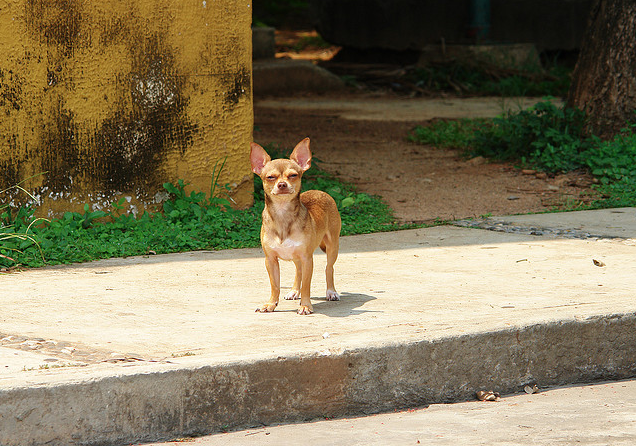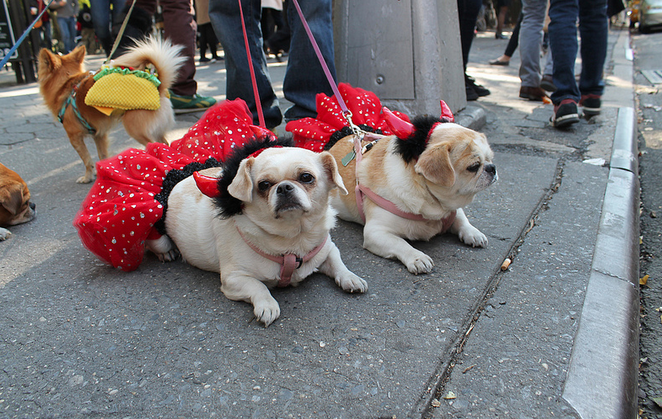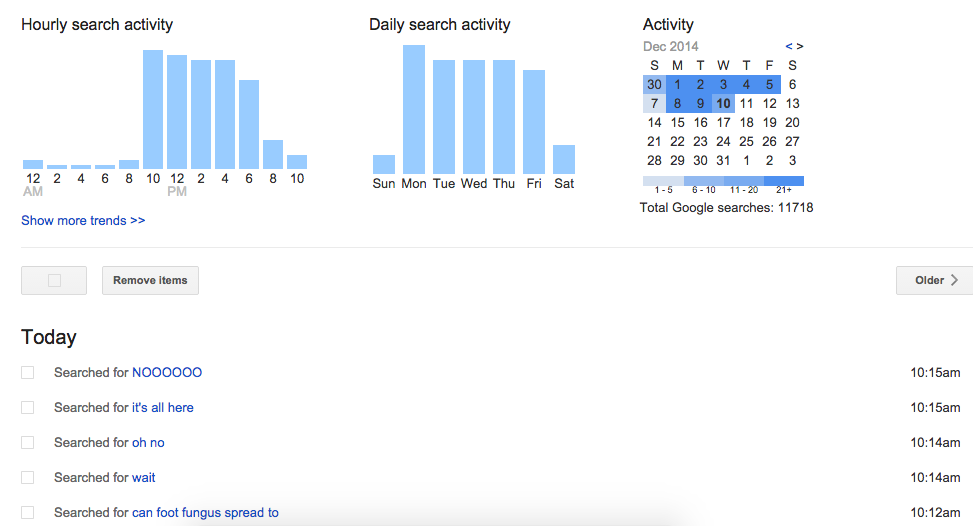New York vs. Los Angeles: Just the Dogs

As the two American population and media centers on opposing coasts, New York City and Los Angeles are prone to endless imperfect comparison. New York has delicious, abundant water, which may or may not make its bagels and pizza so far superior to L.A.’s; in Los Angeles, it is currently in the mid-60s, and will stay that way for the remainder of winter. Now, thanks to the datasets compiled by local radio stations WNYC and KCRW, it is possible to make measure of New York and Los Angeles using a common household pet, the canis lupus familiaris.
First, a note regarding data: The WNYC dog dataset includes 81,542 individuals, pulled from the New York City Department of Health and Mental Hygiene’s dog licensing program list from 2012. Approximately four out of five dogs in New York are unlicensed. The KCRW L.A. dog data offers a similarly incomplete but best-available picture. Pulled from 23 different county and city agencies, as well as the Southeast Area Animal Control Authority, it includes 416,338 individuals. Like New York, many dogs in L.A. are unlicensed, and therefore not included — pit bulls in particular are prone to under-licensing, miscategorization, or misidentification (often willful; people are scared of the very name). Some cities or agencies within L.A. did not respond to requests for data; others limited data due to privacy concerns.1 Both the WNYC and KCRW datasets are similar structured — the KCRW dog project was inspired by WNYC’s — with individuals grouped by name, breed, and zip-code. Other attributes, including sex and coloration, were included but largely ignored in each of the radio stations’ final reports.
How best to parse this data? Our statistical analysis (chi-square for breed and dog names; logistical regression for gender) can be found below. The radio stations arranged individual specimens of canis lupus familiaris by name, breed, and zip code, then displayed the results over maps of the city, so that one is quickly able to ascertain the most prevalent, hyper-regionalized dog specimens. For example, in Malibu, Santa Monica, and Venice Beach, Labrador retrievers2 named Lucy predominate. The same is true on the entire Upper West Side of Manhattan. In fact, the Labrador-heavy neighborhoods in both cities (for the most part particularly affluent — with median household income well-above $85,000/year — and majority caucasian) nearly all favor the name Lucy.3 The similarities do not end there. In both L.A. and NYC, Max4 is the most popular dog name, and Bella5 is the second most popular. But this is not an article about the similarity. No, it is about the difference in New York and Los Angeles canids, and what those differences might tell us about the cities, and their respective cultures and residents. Once the focus shifts, two archetypes emerge.
The Archetypes

The New Yorkie: While New York’s most popular breed is not a breed at all, but “mutts,” attention must be paid to the prevalence of the Yorkie, particularly in the affluent, “cool” “hip” and “tastemaking” neighborhoods of Williamsburg, in Brooklyn, and the Lower East Side, in Manhattan (attention will be paid to the similar “keystone” enclaves of Los Angeles — Silverlake and Echo Park — in the succeeding section).
The Yorkshire Terrier, though initially bred to catch rats in clothing mills,6 rather quickly became a favorite among “families of European high society” according to the American Kennel Club. The breed adapts easily, is self-possessed, sometimes high strung, often quite yappy — and hypoallergenic. Yorkies require more stimulation than most. The AKC posits that this is due to the breed’s grimy, factory roots.
The bustling streets and shoebox apartments of New York make a natural habitat for a Yorkshire terrier. Such environs are perhaps the closest approximation to the rat-infested clothing mills from which the breed sprang. The street-Yorkie is often slightly mixed — as in not purebred, or lacking papers — and can be seen jauntily trotting the sidewalks, appearing athletic, world-weary, and wise. Indoors, the Yorkie may exude calm to the point of uncaring, particularly on subways, or when snuck into offices and waiting rooms. The Yorkie commands attention, but does not demand it. Though it is impossible to confirm, the New Yorkie is probably really embarrassed by Golden Retrievers.

L.A. Chihuahua: The Chihuahua is, by far, the most popular dog breed in the greater Los Angeles area, appearing nearly everywhere except the (affluent, caucasian) labrador strongholds previously described. Great swaths of the region, from San Pedro and Long Beach on north up through Pico Rivera, Hacienda Heights, and La Puente might, for our purposes, be dubbed “Chihuahua Country.” Though Chihuahua Country permeates nearly all parts of the Los Angeles basin as well as many zip codes in the San Fernando Valley.
The most popular name throughout Chihuahua country is Princess. Chihuahuas are also the dominant breed among the hip keystone enclaves of Silverlake and Echo Park, as well as the neighboring Los Feliz, Glassell Park, Atwater Village, and Highland Park. In Los Feliz, which shares demographic traits with labrador country, the most popular dog name is Lucy. In Glassell Park it is Bella. In Echo Park and Silverlake it is Cookie. One member of our expert panel7 cohabitates with a “taco terrier”8 named Cider.
The American Kennel Club begins its Chihuahua breed-report thusly: “Legend and history are rich in tales of the ancestors of the present Chihuahua. He is described as a popular pet, as well as a religious necessity. The Techichi, companion of the ancient Toltecs, is believed to be the progenitor of the Chihuahua.” This is an old, old breed; older than Columbus, who referenced the dog in a letter; older than the Maya; old enough that its size (among the smallest of any canid) might come from the Chinese Crested, brought over from Asia across the Bering Strait when it was still iced over. Anyway, fast forward many thousands of years and you have a desert dog that will shiver if it drops below 70. A real L.A. dog. One owner/panelist described a fleece hoodie used for “chilly” morning or evening walks (“We also have an array of faux fur capes my mother has gotten for her that make her look like Norma Desmond or a dead raccoon,” the panelist noted). Chihuahuas seem to mind dressing up less than most breeds, perhaps because they love burrowing. The temperament of a chihuahua is highly, highly variable. They are loyal to a fault, and look good in sunglasses.
Statistical analysis

By Breed: Chihuahuas, Labrador Retrievers and Lab mixes, Maltese, Pit Bulls, and Shih Tzus were 5 of the 10 most popular breeds in both L.A. and NYC. Of these, we predicted there would be a higher proportion of large breeds in L.A. than NYC. To test this, the proportions of these five dominant breeds were compared between the two locations using a chi-square test.9 We found a significant difference in proportion of breeds from different locations (chi-square = 8465.3, df=4, p<0.001). Certain large breeds were found to be more common in L.A. than NYC. For example, Labradors comprise 9.5% of dogs in L.A. compared to 5.3% in NYC, respectively. However, Chihuahuas made up 15.6% of dog breeds in L.A. and only 4.4% in NYC.10
By Gender: We hypothesized that there would be no preference for male versus female dogs in both cities. While this hypothesis was supported for dog gender preference in L.A. (pmale = 0.504, 95% confidence interval 0.503–0.506), New Yorkers displayed a clear preference for male dogs (pmale = 0.544, 95% confidence interval 0.541=0.547). We geographically explored gender preference using logistic regression and found the only neighborhood in N.Y. in which female dogs were statistically more likely than male dogs was the Upper East Side between 69th and 76th streets (zip code=10021, p=0.04). As a whole, individuals from Manhattan were the least likely to exhibit a preference for male versus female dog (logistic regression, p<0.001). By Name: We found some overlap between most common names in L.A. and NYC. Those names were: Buddy, Coco, Lucky, Lucy, Max, Princess, Rocky. The proportion of dogs with these names differed significantly in L.A. and NYC (chi-square = 100.7, df=6, p < 0.001), largely driven by the finding that 1.2% of all dogs living in New York are named Max.11
Notable regional subspecies:
The French Bulldog: One member of our expert panel12 noted the “French bulldog craze awhile back, circa 2012. I think that this breed appealed to New Yorkers because the dogs had that tough guy bulldog look, but then again, they were French. Every New Yorker wants to think they could withstand a brawl on Staten Island, but also be cultivated and Eurocentric. So French bulldog, there’s your answer. But, as I said, you don’t see as many any more, probably because they all developed joint problems, which probably shows the reality of New Yorkers even more than the ‘French’ or the ‘bulldog.’”
The Shih Tzu: Shih Tzu’s are a very popular breed of canid in New York City, nearly as popular as Yorkies. We have nothing more to say about Shih Tzus.
The German Shepherd: From a Los Angeles-based member of the panel: “Did you know that Armenian men are obsessed with shepherds? Nobody knows why but they are.”
The shelter or rescue dog versus the well-bred store-bought dog: “New Yorkers love to self divide through binaries of class, taste, pizza opinions, whether not it is awesome or monstrous to dress up like Santa and stumble through Manhattan for a day harassing pedestrians… One other great divide is between people who have purchased a dog from a dog store and people who consider this offense on par [with] having interned for the summer with the Pol Pot administration. Shelter dogs are also commonly viewed as having richer emotional lives, the kind of dogs that grapple with real issues and do not know or care who their parents are, and are therefore truer individuals. Bred store dogs, with proper papers, appeal more to the New Yorkers who must control every aspect of everything and who eventually move on to having children, and then form parent groups to lobby against the ice cream truck tempting their children with unhealthy eating habits and against the parks department for setting bricks with potentially sharp edges to line flower beds near children’s playgrounds.”
Dog Culture

In Los Angeles, a member of our expert panel noted that “getting a dog is like being inducted into a (not so) secret society. You meet people! Strangers! Neighbors! You actually talk to them! And they actually talk to you!” New Yorkers shared a similar sentiment, just without the enthusiasm for meeting new people. Mostly, the concern in New York seems to be about other, “poorly socialized” dogs that “terrorize” dog parks. This concern was echoed by our veterinary expert, who suggested the injuries of canids in the two cities would be different — more bite wounds in New York, due to close proximity to other dogs, versus more HBC (veterinary-speak for “hit by car”) injuries in L.A.
Cars are also a consistent source of a dog’s greatest pleasure. Several panelists from both cities mentioned this, though Angelinos all had their own dog-in-car-out-the-window strategy (“She’s figured out how to roll down the windows. Because of this, we crack it, then lock it.”) as there is simply more in-car-dog-time in L.A. One New York panelist stated, simply: “The one great joy of having a dog in New York happens when you leave New York.”
Finally, like humans, dogs must struggle to fit into such built environments. In Los Angeles the urban reality can lull certain canines, and their owners, into a sense of complacency when, in fact, the city is shockingly close to Nature. Many panelists reported true fear of coyotes, rogue waves, and rip tides. In New York, the fear is sloth. “Sometimes I feel bad that he [the dog] spends so much time indoors and that his great natural instincts and physical abilities are totally [going to] waste,” wrote one panelist. “But I think, hey, there are 8 million humans in this city with the same problem, so welcome to city living. Right now, I am typing this and he is sprawled on the floor waiting for something to happen, which it won’t.”
Domain analysis
The anthropologist James Spradley laid out his method of analysing categories within categories in his 1979 work, Participant Observation and The Ethnographic Interview. To begin with, one must establish a unifying semantic relationship — that, for example, X, Y, and Z are all kinds of A. In this case, dogs. We have established two archetypical breeds of dog, our X and Y, the proud Yorkie and historic Chihuahua. Now, we may move to the analysis itself. Spradley usefully establishes possible relationships to examine, that may exists within the data. These include but are not limited to: spatial, cause-effect, rationale, function, sequence, and attribution. We will focus on attribution: that X, or Y, is an attribute, or characteristic, of Z — Z being, of course, Los Angeles or New York.
We have found that the Yorkie adapts easily, is self-possessed and often high-strung, is too yappy sometimes, and requires more stimulation than most breeds. Its roots go back to grimy factory floors, though it is now comfortable among high society. Chihuahuas are made for the sun, enjoy fleece hoodies, and hop up on your lap to either lick or bite your face — you’re never sure. Could it be claimed that either breed is characteristic of its respective city? It could.
Conclusion
Citizens of Los Angeles and New York long for a winner, to be a winner, the winner, the top dog, the Number One Dog Town in America, no, the Whole Damn World. Which is silly, because the best dog town is Portland.
1. An aspect of litigation for which Los Angeles is notorious, due to celebrity culture.
2. The labrador is Volvo station wagon of dogs: “gentle, intelligent, and family-friendly” according to the American Kennel Club.
3. From the Latin, masculine Lucius, meaning “as of light” or, more fittingly for well-kept, frequently bathed, avocado-fed city dogs: “shiny.” Also good for yelling (see: Ricardo, Ricky).
4. Possibly from Maximilian, the saint or Roman Emperor; or from Maximillion, a moniker occasionally used by GZA, co-founder of the Staten Island-based clan of Wu-Tang.
5. One of KCRW’s reports on their dog-project posits that Bella’s rise in popularity could be due to the Twilight franchise, the main character of which is name Bella Swan. Bella also means beautiful, and war, and is a pretty good dog’s name. Way better than Lucy.
6. One of the first Yorkies, or the male from which the breed originated, was named Old Crab, a moniker that has, unfortunately, fallen out of favor. Another, perhaps the most famous Yorkie of all, was named Huddersfield Ben.
7. Including: several dog owners in Los Angeles and New York, as well as a Brooklyn-based veterinarian familiar with the canids of both cities
8. Common slang for a Chihuahua-terrier mix, a mutt prevalent in the Southland
9. Yes, I had to look this up on Wikipedia too.
10. After sharing some of these results with our expert panel, one Los Angeles-based member declared: “Wow, what tragically bad dogs in New York.” He cohabitates with German shepherds.
11. Unless you are a hardcore RZA fan this unoriginality is inexcusable.
12. From Brooklyn, who cohabitates with a Shetland sheepdog named Jockamo.
Photos by: Jonathan Percy; Jane Drumsara; Carlos Massieu; Kevin; Benny Lin; and istolethetv.
Many thanks to Darcy Bradley, a marine biologist, who performed all of the statistical analysis, and has an adorable mutt named Juno.
Maybe You're Sad Because You Aren't Doing Enough Ketamine
“Pharmaceutical companies hope to solve the problem by developing drugs that work like ketamine but without the side effects, which are often described as out-of-body experiences. On Tuesday, at a medical conference in Phoenix, a privately held company called Naurex reported that its drug caused no such psychotic side effects in a midstage trial involving about 400 patients. The drug, called GLYX-13, showed signs of reducing depression in about half the patients tested. ‘It’s definitely the most promising compound in the depression space in terms of effect and durability,’ said Harry M. Tracy, the publisher of the newsletter NeuroPerspective, which follows companies developing drugs for psychiatry.”
Habit Powerful
Patients Prescribed Narcotic Painkillers Use More of Them for Longer, Study Finds
— New York Times headline, December 9, 2014
***
“Hey, I wanted to talk to you about Dad.”
“Sure, what’s up?”
“Remember after his hip surgery he got that big bottle of narcotic painkillers?”
“Yes.”
“Well, he went through it pretty fast. And then he got another big bottle of narcotic painkillers. And he went through that one even faster.”
“Weird.”
“And then he got another bottle…”
“Yes, I’m listening.”
“Anyway. He’s taking like five or six of them a day. And, well…”
“Jennifer, if you’ve got something to say, just come out with it.”
“The truth is I just don’t know what to say. I mean, if I could only find words, or a word, to describe what it is, you know, when you’re prescribed narcotic painkillers and then use more of them, for longer.”
“Right. It is a strange thing.”
“His surgery was over four years ago.”
“Was it really? Well, that is very odd that he is…how did you put it again?”
“I think I said something like — I don’t know, he was prescribed narcotic painkillers and then used…”
“Right, right, then used more of them, for longer. Right. Well. Best perhaps to just keep an eye on things.”
“I suppose. No point in freaking out when we have no idea what we’re dealing with.”
Rise and Grind
Rise and Grind

Last week, after ten months of living in relative harmony with one another, my daughter suddenly and without any warning developed a new habit which made me briefly want to reconsider our life together. A habit so disgusting and terrible to me that I reacted, not in anger, but in astonishment and anxious surprise.
She was sitting in her high chair, waiting impatiently for her lunch. She is always impatient in her high chair, often resorting to a high pitched, insistent yelling which is ear piercing, but which I have gotten quite good at almost not even hearing. I was at the kitchen counter, probably ten feet away. I heard something that sounded like metal gears grinding against one another. We live in an ancient house with ancient sounds all its own, so I ignored it and finished preparing her food.
I walked over to her. She was still yelling and beating her hands on the tray of the chair. I sat down in front of her in my own chair, and put on her bib. She smiled at me, showing me all seven of her beautiful white teeth. And then I heard the noise again, and realized it was coming from her mouth. She was grinding her teeth. Loudly.
“Zelda, no!” I didn’t yell but didn’t quite whisper either. I reached out and touched her cheek. Her smile got wider, and I could see her teeth, jaws clenched, as she ground them against one another maniacally. I dropped the spoon I was holding and put my hands to my ears.
In that moment, blinking in horror at my daughter, I realized that this thing, this teeth grinding, was a sign that I didn’t really know her. I didn’t know what she was capable of. This tic, a seemingly unintentional or at least subconscious behavior, and its capacity to instantly annoy me, in that moment, showed me that we both had a long way to go in getting to know one another. This moment arrives early on in any major relationship: that little thing you don’t notice at first suddenly is so present it’s the Only Thing. But this was different: Zelda and I, we’re never breaking up. We don’t want to; we can’t. We must learn to live together despite whatever annoying habits we both have (and believe me, she’s going to be annoyed by old Mama soon enough).
Now, it’s important to understand that this wouldn’t have been possible a few weeks ago, before Zelda had opposing teeth. But, as soon as she was able, basically, she started grinding her little uppers and lowers together. I watched for signs of anxiety — I used to grind my teeth in my sleep when I was young, too. But she was doing it when awake, and there was no sign that she was doing it from anxiety. In fact, she seemed to think it was quite funny.
Not reacting is a key to getting your child to cease behaviors you don’t like. It doesn’t always work — I’ve been patiently hoping my daughter will stop happily yelling as loudly as she can for sport and attention for months, pretending I don’t hear it and calmly responding to her needs as I can — with no luck. It seems the yelling is just part of her general attitude, or a longer phase than I’d hope. Fine.
So I ignored it, and distracted her, first with food, which worked. Then we went out for the day, strolling around, and the behavior didn’t repeat. That night as I was getting her ready for bed, I heard it again. And then next morning when we were sitting on the floor playing with her books. Grind, grind, grind.
I am terrifically disturbed by certain types of sounds. I was plagued throughout my childhood by the sounds of my younger brother chomping on ice. To this day that sound makes me want to peel my skin off manually. And, until recently, I must admit that the sound of a crying baby — especially in an enclosed space such as the subway or an airplane — made me feel like committing murder. But we’re adaptable, it turns out, and now instead of being horrified, I am simply alarmed and concerned. I’m a patient person, largely, but certain grating noises just make me feel like I’m crumbling internally. Sounds like the grinding of teeth.
The internet was no help. Babies grind their teeth, it turns out. Sometimes, they’re just getting used to having teeth in their mouths. Sometimes, it is anxiety, and rarely it is… pinworms.
Two days into the grind, I called Zelda’s pediatrician. I already knew what they were going to say — it would likely go away on its own, I should try to distract her, blah blah blah. But first I wanted to make sure it wasn’t a sign of something I should be concerned about (it’s not!) and second, I just needed to vent. I was home alone with a baby who was smiling at me while her clenched jaws made a sound — eh eh eh eh eh — over and over. The nurse told me what I knew she would: “it’s okay to ignore her when she does it. You can try giving her other things to chew on, she’ll probably stop relatively soon.”
“Honestly, this is going to sound dumb or terrible,” I said woefully into the phone, “but, the main thing is this: I just want to leave the room when she does it. It drives me crazy, it sounds so, OH MY GOD ZELDA STOP IT sorry she is doing it right now.” “I totally get it, it’s unnerving,” she said. I wondered if she did get it. “Ugh does she even have a kid?” I thought to myself as I hung up the phone. Mine, no longer grinding her pearly whites, sat not one foot from me, chewing on a book.
It’s been about a week. She still does it. Not much — I didn’t even hear it once yesterday. I’m adjusting. I distract her with teething rings and toys. I pretend I don’t notice it just in case noticing would inadvertently encourage this insane behavior that I am just capable of tolerating.
I was prepared for illness and fears, for having to learn how to keep a baby from danger, for having to teach her “yes” and “no.” Nobody warned me that she might grind her little teeth in front of me like a pet cat bringing a live mouse to your front door, thinking it’s a wonderful treat. Who is this stranger with the manners of an animal sitting in front of me?
I’m making more of it than it is, of course. But in those few seconds that I hear the grinding, I am reduced to a pile of dust. A husk of a person, irrational and — not angry — but just horrified and anxious. A pile of dust, like Zelda’s teeth will be, should she continue along this path which she has gleefully, and without regard to her mother’s ears, chosen.
Photo by John Johnson
Everyone's Worst Page on the Internet

The Sony hack is mythic in scope and form: Unlike the hundreds of “data breaches” that have cycled through the news over the last five years, this one is complete, and happened all at once. This has resulted in notable and delicious news and will result in more. But, also:
The most painful stuff in the Sony cache is a doctor shopping for Ritalin. It’s an email about trying to get pregnant. It’s shit-talking coworkers behind their backs, and people’s credit card log-ins. It’s literally thousands of Social Security numbers laid bare. It’s even the harmless, mundane, trivial stuff that makes up any day’s email load that suddenly feels ugly and raw out in the open, a digital Babadook brought to life by a scorched earth cyberattack.
Yes! Every computer comprises a hideous dossier. Look at your laptop: It could destroy you, even if you’ve done nothing wrong.
This realization should be compounded by the knowledge that most of what’s “on” your computer actually lives somewhere else, too, in the servers of companies that are interested in protecting your data only insofar as it preserves their business interests, which are, generally, variations on data marketing and the sale of advertising, to which appearances of privacy and security are helpful. Modern life is a digital nesting doll of latent blackmail opportunities and neglected, decaying data warheads.
In one view, we are conditioned to ignore this; in another, we’ve simply learned to cope. Maybe we’ve become more cautious about what we email? Certainly people are savvier — or at least, more conscious — about their social media posts than they were half a decade ago. We’ve gotten better at controlling the things that we obviously control. We have become, perhaps, SLIGHTLY COMPLACENT. Which is why this page is useful:

Visit it yourself:
At the top of the page, as if to acknowledge the universal unease felt by viewers, is an assurance from Google:
Only you can see your history
Sure! You, or anyone who finds your password, or anyone you allow to use your computer for a few minutes while you’re still logged in. Are you unsure if you have a sexually transmitted disease? Did you do some panicked research? It’s there! Are you attempting to figure out if your depression matches a pathology or if it’s just some kind of mood? That’s there too. Things that are not bad become bad by virtue of their recording and display on this very creepy website. In a vacuum, this page is an interesting read: It’s a more honest assessment of your online activities than perhaps anything else. But we don’t live in a vacuum! We live in an accelerating data-commerce cyber-hell.
The Tunes We Tried To Distract Ourselves From 2014 With
I spent most of 2014 walking around in a daze, battered by the realization that everything was terrible and only getting worse. I was tired of words. We had more words than we needed and no one was willing to shut the fuck up, so I tried to keep myself quiet at least, because so many of those worthless words were mine in the first place and I knew I would never be able to stay silent enough to make up for that. Above, in no particular order, the tracks available on Soundcloud from the albums I enjoyed this year. You will note that most of these songs lack lyrics. This is deliberate, and the tracks with words are begrudging exceptions. I am all for noise, it’s the words I can’t stand. Below, and again in no particular order, a list of the records released in 2014 that made me briefly forget just how awful everything was.
• Objekt, Flatland
• Clark, Clark
• Arca, Xen
• Patten, Estoile Naiant
• Andy Stott, Faith in Strangers
• Celer, Sky Limits
• Ricardo Donoso, A Song for Echo
• Dirty Beaches, Stateless
• Ryan Teague, Block Boundaries
• Bitchin Bajas, Bitchin Bajas
• Jo Johnson, Weaving
• Bing & Ruth, Tomorrow Was the Golden Age
• Jani R, Fragile
• Pierre-Laurent Aimard, Bach: The Well-Tempered Clavier I
• Beacon L1
• Various Artists, Hyperdub 10.3 [N.B.: All the Hyperdub collections are good, but this is the most consistent]
• Loscil, Sea Island
• Steffi, Power of Anonymity
• Leonard Cohen, Live in Dublin
• Vicky Chow, Tristan Perich: Surface Image
• Todd Terje, It’s Album Time
• Various Artists, Kompakt: Total 14
• Christopher Bissonnette, Essays in Idleness
• Christina Vantzou, No. 2
• Huelgas Ensemble, La Oreja de Zurbarán
• A Winged Victory for the Sullen, Atomos
• Wolfgang Voigt, Ruckverzauberung 9 / Musik Fur Kulturinstitutionen
• Arp, Pulsars e Quasars
• The Dublin Guitar Quartet, The Dublin Guitar Quartet performs Philip Glass
• Siinai, Supermarket
There were some excellent reissues this year but even though everything is terrible and only getting worse that’s no excuse to live in the past. It’ll all be over soon; you might as well focus on what’s left. You cannot jam the earbuds in deep enough to block everything else out, but that doesn’t mean you can’t try. Enjoy.
Relations Threatened
“The new publication, with a mission of ‘covering the politics, policies and personalities in the EU and the continent’s most powerful nations,’ according to POLITICO C.E.O. Jim VandeHei, will take the flagship’s model of high-volume politics and policy news and tailor it to a European audience through a combination of free digital content, a subscriber service and an advertiser-supported print edition. POLITICO Europe also will come with its own, E.U.-centric version of chief White House correspondent Mike Allen’s popular morning email tip-sheet, Playbook.”
New York City, December 8, 2014

★ Breath misted in the blue twilight where morning should have been. A light was on atop the apartments to the west, as if in the nighttime. Milky ice hugged the gutter beneath a breakfast cart. The 1 train was delayed and packed and ultimately possibly worse than a walk in the cold would have been. Sparrow song floated over the lower platform at Columbus Circle. The middle of the day made it to a dark gray and no further. Some puddles had melted and others were still iced, depending on the microclimate block by block, or on how much filth was dissolved in their water. The wind hurried the body along with a shove to the back. Building management had sent out a warning letter about the gale to come, and toward sunset the building itself began to wail.
If You Still Buy Books Here Are A Couple You Should Buy
I am not the type of man who makes resolutions, knowing through bitter experience that past a certain point in life people are who they are and all the best intentions in the world won’t make any difference. Everything ends in failure and even the effort involved in trying to be better is energy you will regret having spent once your pathetic attempt at improvement proves once again to have failed and you find yourself doing the same sorry thing you did before, only now it carries an extra layer of self-loathing because of your inability to get it under control. The older you get the more clearly you see just how awful you turned out and how that’s the best you’re going to be, because you can’t change and it hurts too much to even try. That said, if I were trying to make myself something less worthless than I currently am I would resolve to read a couple more books next year. I don’t know how I set the bar so low that I find myself at a point where just making it through the fucking magazines for the month feels like some kind of medal-winning achievement, but that’s where I am at present. I mean, it is not at if I can point to any other tangible feats I have accomplished while not reading either. What else am I doing with my life besides being sad? Nothing, that’s what. And yet, in 2014, I read fewer books in any other calendar year than I have read since I achieved literacy, beating my previous poor showing in 2013, 2012, and each preceding year in a decade-long troubling trend of diminishing attention span and growing disinterest. I have almost given up on fiction entirely, because there is nothing most modern fiction can do for me. I mean, I suppose I would still read novels about post-apartheid South African photographers or Jamaican gang wars or 17th-century French lacemakers, but there is not much else that the type of people who write today’s modern fiction can tell me about what it is like to be a tortured, artistic soul in post-millennium Manhattan (or Brooklyn, I guess it’s Brooklyn now) that I don’t know now or can’t see coming anyhow. I UNDERSTAND ALL THOSE PRECIOUS FEELINGS ALREADY, I don’t need to see them padded out with contemporary product names and descriptions that overuse the words “middle distance.” Anyway, looking back I think there is only one book I read all the way through this year, and it was the reissue of Bob Colacello’s Holy Terror: Andy Warhol Close Up, which, even though it is long and repetitive and a carousel of nonstop vacuity, I was unable to put down; it gives you an insider’s view of how everything turned to shit from the top of the cultural pile and then trickled down to everyone else. I say that without judgment, because honestly what difference does it make anymore, we’re under a pile of doody so enormous that we’ll never have enough shovels with which to dig ourselves out, why not be entertained by watching how it happened in the first place? Couple this with the recent re-release of The Andy Warhol Diaries (a book that no New Yorker’s library was complete without back when New Yorkers still had libraries) and you’ve got a pretty good present for someone on your list who likes that sort of thing, or even just something to give to yourself. You’re worth it. I mean, you are, not me. I only read one fucking book last year, you can see what kind of scumbag I am.
